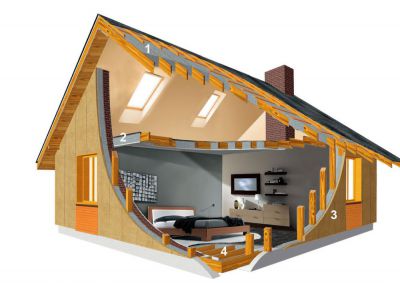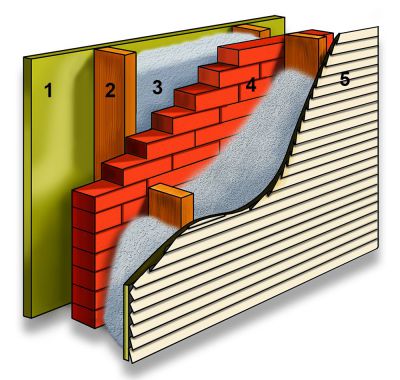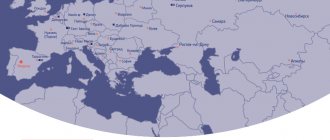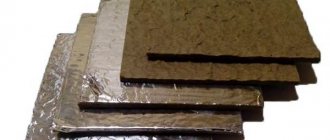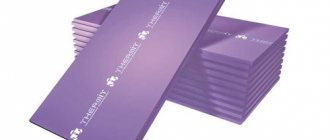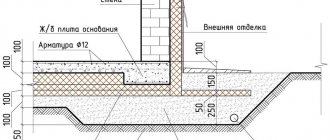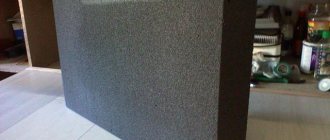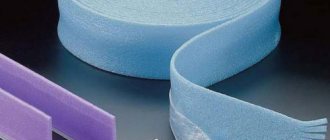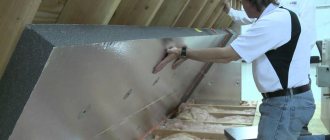
Today, in the USA and Canada, cellulose-based insulation is used in almost 70% of frame houses. In Russia, this material has been known since the middle of the last century, but to this day, the domestic consumer treats it with caution. Why?
Cellulose insulation (ecowool) was developed at the beginning of the last century, during the construction boom, when practical and inexpensive materials were in great demand.
The product, which is based on recycled paper, came in handy. It is because of the opened possibility of recycling waste, which used to simply litter the environment, that the prefix “eco” appeared in its name.
EVERYTHING YOU NEED FOR THIS ARTICLE IS HERE >>>
What is ecowool made of
So, most of this insulation (about 81%) is cellulose, or, more precisely, recycled paper. Antiseptics and fungicides (boric acid or ammonium sulfate / phosphate) account for up to 12%, which provide protection against pests. Finally, 7% are fire retardants. The material is extremely easy to manufacture (a full cycle takes only five minutes) and is affordable. Ecowool has other advantages that make it popular in the USA and European countries.
Reference by topic: Ecowool - advantages and disadvantages of the material. Laying ecowool with your own hands
First of all, these are high heat-insulating properties. With a thermal conductivity coefficient of 0.037-0.042 W / (m-K), a layer of sprayed ecowool of 150 mm corresponds in energy saving to a brick wall 4.5 bricks thick. The technology of applying the material (backfill or spraying) provides a uniform heat-insulating layer without voids, seams and breaks.
Despite its "paper" nature, cellulose insulation does not ignite upon contact with fire, but only smolders and, having lost a heat source, extinguishes itself. Due to the capillary structure of cellulose fibers, it is able to retain up to 20% moisture in the upper layers without losing its heat-insulating properties.
No vapor barrier is required for it. Antiseptic additives make ecowool immune to attacks of harmful microorganisms, insects and small rodents. It is also worth noting that cellulose insulation is distinguished by high sound-insulating characteristics, significantly surpassing mineral wool in this indicator. A 100 mm layer of material reduces the noise level by approximately 60 dB. If you use it not only in the outer walls, but also in partitions, the house will become much quieter.
Using ecowool
Thermal insulation of a frame house with cellulose insulation implies two installation methods: - during the construction of the building itself; - during repair work. The second option involves the sealing of voids formed as a result of the deformation of the original insulation. In this case, holes with the diameter of the installation hose are made in the walls around the perimeter of the house. After that, the dry material is blown out with a special tool and the previously drilled holes are masked. It is even easier to install ecowool at the time of building a house. Holes are made at the stage of preparing the frame and carefully removed after placing the insulation. Cellulose fibers adhere perfectly to each other and to surrounding objects, filling the corners and preventing the formation of voids. Also, ecowool does not need an additional vapor barrier film.
- Back to
- Forward
Ecowool composition
As mentioned above, ecowool is made from paper raw materials with the addition of antiseptics and fire inhibitors.Let's consider these components in more detail and start with the main thing - waste paper. Overseas manufacturers tend to use ink-free paper, which is known to contain unsafe lead. Unfortunately, domestic companies sometimes do not disdain newspapers and other waste materials that are not suitable for the manufacture of thermal insulation. Therefore, when buying ecowool, it is important to at least visually check it for scraps of cardboard, coated paper (which forms the smallest dust), rags and other debris.
Boric acid is a time-tested antiseptic that raises no questions. Its concentration is too low to create any health problems for the residents. But with fire retardants, everything is more complicated. The fact is that ammonium sulfates and phosphates used by some manufacturers can be a source of an unpleasant ammonia odor.
In addition, over time, these substances lose their fire-fighting properties, as evidenced by research conducted at the California Bureau of Home Furniture and Insulation.
Borax (borax) does not have the above disadvantages. So when choosing a material, it would be reasonable to give preference to the one in which the borax was used. By the way, borax is an additional guarantee that rodents will not start in the wall structure - they do not tolerate this substance.
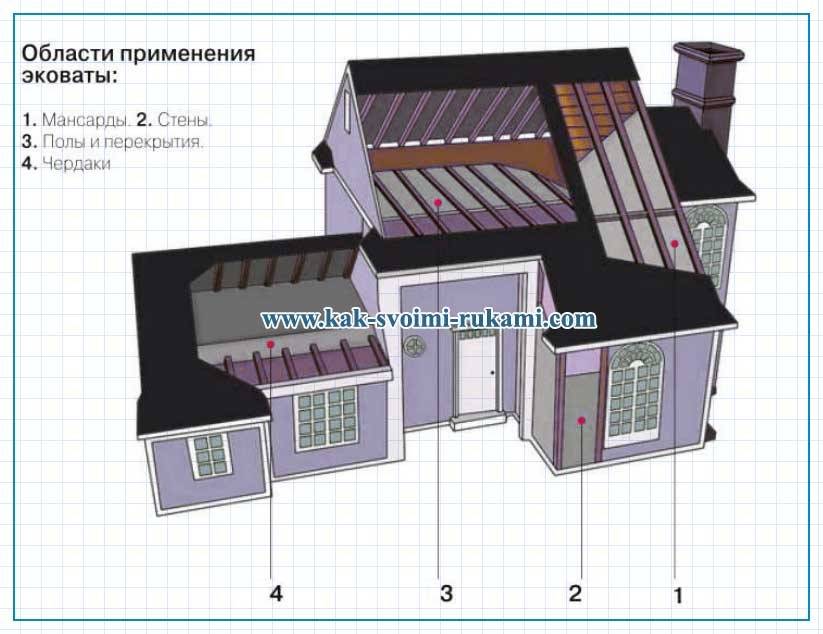

Scopes of ecowool: 1. Attic. 2. Walls. 3. Floors and ceilings. 4. Attics
Distinctive features of the material
The development of the first cellulose-based insulation dates back to the beginning of the last century. To this day, the material is especially popular in Canada, Europe and the USA - about 70% of frame houses are insulated with ecowool. In Russia, it is less in demand, since it began to be produced here a little over 20 years ago. The development of cellulose manufactories fell on the pre-war period, but then began to decline. Only in the second half of the 20th century, the popularity of ecowool began to grow, since, due to military losses and expenses, an urgent need arose for a material, the components of which would be available and cheap.


About 4/5 of the ecowool composition is recyclable - recycled paper. 10-12% are antiseptics with fungicides (the latter protect against unwanted microorganisms, rodents, mold and mildew), the remaining 7-10% are fire retardants (additives that prevent the material from igniting) and fire inhibitors.
Cellulose insulation is produced quickly and easily. The whole cycle takes 5-7 minutes and includes the following steps:
- delivery of recycled paper (waste paper);
- backfilling it onto a conveyor belt, entering the primary mixer;
- extracting staples and staples in the paper using magnets;
- dividing sheets into strips 5 cm wide;
- adding antiseptics and fire retardants;
- the flow of the mixture into the secondary mixer, which grinds the raw material to granules with a diameter of 4-5 mm;
- the addition of borax (sodium boric acid), after which the insulation can be considered ready.
The end product is a gray, loose heat-insulating material, which in structure resembles a cross between cotton wool and fluff.
Ecowool installation
Cellulose insulation is used for thermal insulation of walls, interior partitions, mansard and attic rooms, as well as roof structures and floors on logs. But you cannot lay it under the screed: it is a loose material that needs free space. Ecowool is delivered to the object compacted (3-5 times of the nominal density), therefore, it must first be restored to its original state. When laying by hand, the material is loosened with improvised tools in any large container and laid out on insulated surfaces (floors, ceilings) or poured into the cavity of frame walls and ceilings. It is very important to observe the density of application: for horizontal structures it is 35-40 kg / m3, for vertical ones - 60-70 kg / m3.This method requires a lot of time and effort, and therefore is used extremely rarely, only with small amounts of insulation.
Much more productive is the application by means of a blowing installation, which loosens the insulation in the bunker and delivers it in an air stream to a distance of up to 200 m horizontally and up to 40 m vertically. In this case, the material penetrates into the most inaccessible cavities and gaps, forming a continuous and seamless heat and sound insulation layer. The technique allows you to regulate the density of the blown insulation, which means that it becomes much easier to observe the quality of installation. It is important that the ecowool is blown out with a margin of 10%, since even with the most competent application, it will settle down a little over time.
Well, wet laying is considered the most reliable, when ecowool is applied to structures with water or diluted glue, which noticeably increases its adhesion to the base. The wet-glue method, used primarily for inclined surfaces (pitched roofs, vaults, arches), allows you to achieve a perfectly uniform and even layer of insulation.
Reference by topic: How to properly insulate a house. Insulation schemes


Paper insulation, or is it worth it to insulate the house with ecowool?
In Canada and the USA, about 2/3 of frame houses are insulated with cellulose-based materials. In Russia, paper thermal insulation has been known since the middle of the twentieth century, but it has not yet gained popularity. Why?
As the name suggests, most of this insulation (about 81%) is recycled paper. The remaining 19% are antiseptics against pests and fire retardants that protect against fire. The material is extremely simple to manufacture, therefore it is inexpensive.
Scopes of ecowool
But it is much more important that the paper insulation (aka ecowool) does an excellent job with its duties. Only 15 mm of paper mix corresponds to the heat saving of a brick wall with a thickness of 4.5 bricks! In this case, the layer is homogeneous, without seams and voids. It is also important that it “breathes” perfectly, and therefore does not need a vapor barrier.
Another plus of ecowool is that it can also serve as a sound insulator. A 100 mm layer reduces the noise level by approximately 60 dB.
Fire safety. For a material that is shredded paper, this issue is of great importance. As practice shows, cellulose insulation does not ignite upon contact with fire, but only smolders and quickly fades away, having lost the source of heat. But still, it is worth dwelling on fire retardants in more detail.
Some manufacturers use ammonium sulfates and phosphates, which give off a strong and unpleasant odor. But this is not the main problem. The trouble is, over time, these additives lose their flame retardant properties. Therefore, it is better to purchase material impregnated with borax (borax). This fire retardant is devoid of the disadvantages described above.
Borax protects not only from fire, but also from pests. Rodents cannot stand this substance, so they will not settle in the insulation layer.
Water resistance. It would seem that the paper is not "friends" with her. First of all, we note that it is impossible to allow any insulation to get wet - this has a very bad effect on its properties. But if an accident does occur, the cellulose fibers will retain some of the moisture that has fallen on it in the upper layers, from where it will quickly evaporate, so that the material will not be critically damaged.
Installation
Opening the topic of installation, we emphasize that cellulose insulation is used to protect walls, attics, attics, roofs and floors on logs. But you cannot lay it under the screed - under the weight that has piled on, the loose material will become dense, which will reduce its useful properties to zero.
Insulated wall construction
Ecowool is supplied in a compacted state (briquettes), which means that it must first be loosened.If manual laying is intended, this can be done with any convenient tools in a large container. Then the paper pulp is poured into the cavity of the frame walls and floors. It is very important to observe the density of application: for horizontal structures it is 35–40 kg / m³, for vertical structures - 60–70 kg / m³. Obviously, this work takes a lot of time and effort. It is much faster and easier to apply the material using a special blow molding machine. She herself loosens the insulation and feeds it under pressure to a distance of 200 m horizontally to 40 m vertically. At the same time, ecowool penetrates into the smallest cavities and forms a uniform heat and sound insulation layer. The density of application can be adjusted.
With machine insulation, it is important to ensure that the ecowool is blown in with a 10% margin, since the material will settle down a little over time.
The third installation option - wet installation - is considered the most reliable. The pulp is applied after mixing with water or diluted glue. This technology is usually used for the treatment of inclined surfaces - vaults, arches and pitched roofs. It is important to take into account that the moisture contained in the insulation can damage the structure itself, therefore, all fasteners, wires, pipes and other metal parts must first be covered with anti-corrosion compounds.
disadvantages
So, it would seem that there are no obvious problems. So why is this insulation not popular with us? There are several reasons.
Let's start with the fact that in Russia there is no standard for the composition of paper insulation, so the manufacturer can regulate the quality of the product himself. It is unnecessary to say what this sometimes leads to.
There are also moments of risk during installation. Workers interested in saving material can apply a looser coat than necessary. This means that tight control is needed.
Although the ecowool does not burn, it smolders, which means that when insulating attics and attics, you will have to insulate chimneys with non-combustible materials.
Finally, the most noticeable drawback is the price. The material itself is cheap, but the services of workers and depreciation of equipment will also have to be paid. The average cost of 1m3 "turnkey" varies from 1700 to 5200 rubles
How to check the quality of ecowool?
- Study information about the manufacturer, read reviews.
- When buying, you should pay attention to the packaging. It should be transparent and intact, without holes and cuts, in this case, the insulation briquettes will really be protected from moisture.
- High-quality insulation is gray. Do not take yellow or white. Unsuitable raw materials were obviously used for its production - cardboard or office paper, which form fine dust.
- It is useful to open one or two packages and wrinkle the material in your hands. Good ecowool should be like fluff. Dust and large pieces of paper are an indicator of poor quality. Particles in the form of grains of sand are another cause for concern. They indicate that the chemical additives are poorly mixed with the furnish.
- It is not superfluous to set fire to a small portion of ecowool. It should smolder and fade on its own.
- Before buying, you should ask the seller for sanitary and hygienic and fire certificates. The lack of documents for the goods, as well as the sale of ecowool at an unusually low price should alert the buyer. Perhaps, under the guise of wall insulation, they sell simple paper crumbs without additives that provide bio- and fire resistance.
Disadvantages and disadvantages of ecowool
And now it's time to answer the question: what is holding back the spread of this insulation in Russia?
First of all, the fact is that in the Russian Federation there are no regulatory documents regulating the composition of ecowool, which means that the quality of products remains on the conscience of manufacturers. It is also worth noting that, although ecowool does not support combustion, it can smolder, because it is a woody product.Therefore, when insulating attic, attic rooms, additional insulation of the chimney with non-combustible materials is required.
Moisture in ecowool applied by the wet-glue method can have a bad effect on the surface to be insulated. All metal elements (fasteners, wires, pipes) must be painted or varnished to avoid corrosion, because the material will dry for quite a long time, up to two months. And of course, finishing work will have to be postponed for this time.
Finally, the most noticeable drawback is the price. The material itself is cheap, but for its high-quality application, qualified personnel are required, whose services will have to be paid. And the depreciation of the equipment will be included in the price. On average, the cost of a cubic meter of insulation with turnkey installation, depending on the density and application technology, ranges from 1700 to 5200 rubles.
How to choose the right ecowool?
The purchased thermal insulation will be beneficial only when the buyer is careful when choosing and takes into account the recommendations listed below:
- The lack of marking on the label and documents for the goods is the first wake-up call for the consumer.
- Require the seller to provide certificates - fire and sanitary. They contain information on the composition of the cellulose. If ammonium sulfates are used instead of the required boric acid, the biostability will be minimal, and the insulation will quickly collapse.
- An unexpectedly low price in comparison with analogs should cause the buyer to be wary. There is a possibility that ordinary shredded paper without additives is being sold under the guise of ecowool.
- Get as much information as possible about the manufacturer, read user reviews.
- If possible, study the material externally. It resembles fluff, does not have large fractions, but at the same time does not look like dust.
- Ecowool, wet to the touch, is not an option, even at a reduced cost.
- Material deviations towards gray or yellow are unacceptable. These are the first signs of using second-rate components.
- If the ecowool is shaken, fine fractions like sand should not appear. If there are any, before the user is ordinary shredded paper, for which the manufacturer was greedy for boric acid.
Considering the recommendations listed above, there is a chance to acquire reliable thermal insulation, the parameters of which will be no worse than mineral wool counterparts.
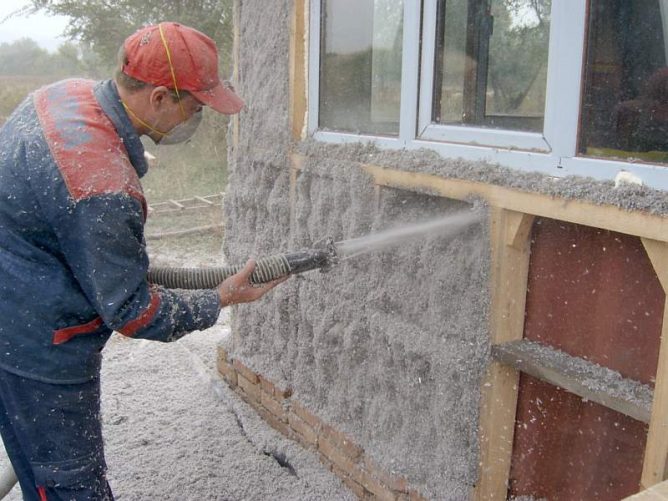

Ecowool insulation - backfill: photo
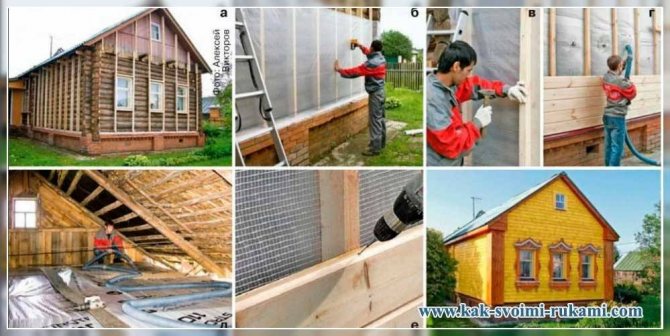

a) The lathing beams with a cross-section of 100 * 50 mm, necessary for the subsequent installation of the film "cover", are placed on the edge b, c) The vapor-proof film is fixed with a stapler and staples d, f) The walls are sheathed with a board imitating a bar, tightly pressing the cladding to the ebb above the foundation e) Ecowool for a warm "blanket" of the attic floor is sprayed with a density of 35 kg / m3 in a thick layer. This ensures that all cavities in the structure are filled.
Nuances of warming various parts of the house
Wall insulation
Thermal insulation of the main supporting structures can be achieved by using cellulose both outside, under ventilated facades, and in interior decoration, under cladding made of sheet materials.
In any case, the profiles for the subsequent wall panels should be attached to the walls first, and then the insulation should be applied using the chosen dry or wet technique. By the way, unlike laying, dry spraying allows you to apply thermal insulation under already finished panels through the holes left for these purposes.
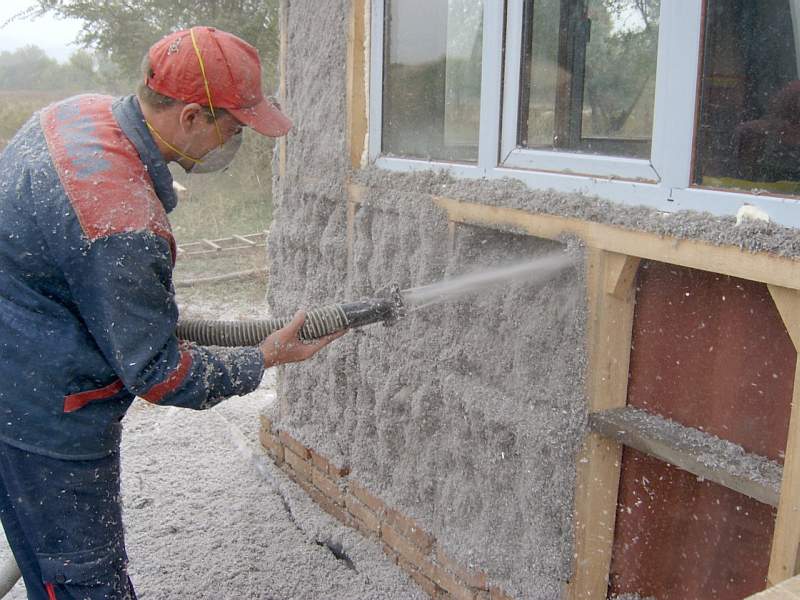

Insulation of the facade from the outside
When working with facades, the thermal insulation properties of the wall material should be taken into account. The savings go in two directions. Firstly, the costs for the foundation are reduced, and secondly, for the vapor barrier film, since the insulation itself is breathable. Construction costs can be saved up to 30%!
Roof insulation
In terms of thermal insulation, ecowool is ideal for the installation of heated attics and attics, as it is considered environmentally friendly and does not allow heat leakage. For these purposes, the thickness of the material should be at least 75 mm, optimally 100 mm.
Again, it is necessary to install the hydro-barrier from above, while the vapor barrier from the inside of the room can be abandoned. Special attention should be paid to the thermal insulation of the attic floors, as well as the insulation of the loggia.
Sprayed insulation under the roof
Floor insulation
A lightweight cellulosic material is a good choice for intermediate floors and, consequently, for upper floors. In addition, the sound insulation in the room will also increase. The underfloor heating system involves laying cellulose on a primary "rough" screed, under which, in turn, a sand-crushed stone cushion is laid.
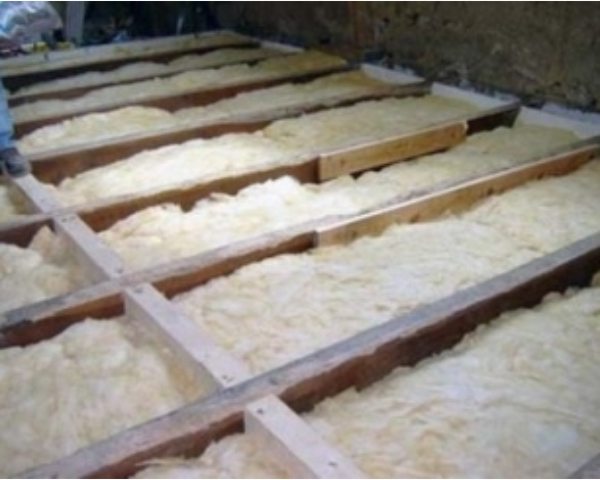

Manual installation of cellulose fibers under flooring
This procedure can be done in two ways:
The first is to manually lay the fluffed fiber under the floor covering;
The second is spraying using an air gun through holes left in the floor in advance.
Thermal insulation with ecowool - house in 10 years - video
Ecowool in 10 years
© Author Yu.Leshkevich
TOOL FOR MASTERS AND MASTERS, AND HOUSEHOLD GOODS VERY CHEAP. FREE SHIPPING. THERE ARE REVIEWS.
Below are other entries on the topic "How to do it yourself - a householder!"
- Ecowool - the advantages and disadvantages of the material. Laying ecowool with your own hands Thermal insulation of the house with ecowool and characteristics ...
- Insulation spraying: comparisons of ecowool and polyurethane foam Which insulation is better - polyurethane foam ...
- Device for folding clothes with your own hands CONVENIENT DEVICE FOR FOLDING CLOTHES To ...
- Stable do-it-yourself folding goats for a workshop - photo and drawing Folding goats for a workshop with your own ...
- Stand for vertical storage of tools with your own hands (+ drawings) Vertical storage of tools in the workshop ...
- How to make a clutch for a baby stroller - photo and diagram DIY clutch for a stroller We offer ...
- DIY zipper bracelet (PHOTO + STEP-BY-STEP DESCRIPTION) HOW TO MAKE A BRACELET FROM A REGULAR ...
Subscribe to updates in our groups and share.
Let's be friends!
With your own hands ›How to choose or how to make› Encyclopedia of building materials › Ecowool (cellulose insulation) - use in construction
Advantages and disadvantages of blown ecowool
The composition of the blown cellulose insulation can be basalt, fiberglass and cellulose. Basalt mineral wool is made from basalt rock, and formaldehyde is not added to it. Glass wool is the result of shredding thermal insulation boards, cellulose insulation is made from waste paper. Fire retardants and antiseptics are added to all types of thermal insulation.
Advantages:
- Low thermal conductivity and light weight;
- High moisture and vapor permeability;
- Fire safety and incombustibility;
- Long service life;
- Easy installation.
Disadvantages:
- Compressor equipment is required for work;
- On a drywall surface, ecowool should be applied in two layers to avoid swelling of the surface;
- The need to waterproof the surface;
- The high cost of use with small amounts of insulation.


Performance properties of blown ecowool
Calculation of the ecowool layer
The starting data you will need:
- Building material for building walls;
- Average annual thermal resistance in the region (reference information);
- How many external doors and windows are in the house;
- Additional heat leaks;
- Insulation material and heat transfer coefficient.
The formula for calculating the value of the degree-day of the heating period in the region:
GSOP = (T1 - T2) x Z, where:
- T1 - the optimal temperature in the dwelling (18-220C);
- T2 is the average annual temperature outside;
- Z is the number of days in the heating season.


Data for calculating GSN
After calculating this regional parameter, you can proceed to clarify the thickness of the thermal insulation layer on the surfaces of the residential building. The thickness of the insulation will also depend on the building material of the walls, ceiling or floor - for brick, concrete, cinder block or wood surfaces, the results will differ.
Preparation of molding sand
The period of soaking and preparation before the molding stage is ten days, the constituent components of the mixture must be measured accurately, as a container, you can use an ordinary metal barrel of 200 liters:
- The paper is weighed, shredded as much as possible and poured into the container;
- Water is poured into the container slightly above the paper level for the initial soaking for two days;
- After the soaking procedure, water is added at a total rate of 20 liters per kilogram of paper;
- 100 g of any machine oil and the same amount of water are whipped with a mixer (based on a 200-liter capacity);
- The mixture is added to a container with paper and water - this is an additive for hydrophobicity;
- For the same volume, it is necessary to add 100 g of ordinary baking soda as a fire retardant and 20 g of boric acid as an antiseptic;
- The mixture is whipped as thoroughly as possible using a construction hand mixer or similar - using a conventional drill;
- The mixture settles for a week;
- After settling, the mixture is whipped again to obtain the most homogeneous mass.
We offer you to familiarize yourself with What vegetables grow nearby
Thermal insulation from cardboard, sawdust and kraft paper
Ecowool is a waste paper processing product, almost entirely consisting of cellulose.
But for the insulation of frame structures, it is possible to use paper and cardboard, both without processing, and for the independent production of insulation boards.
With irregular living, insulation for the walls of a country-house frame house is most often determined by price position, that is, which is cheaper, the better, especially since the quality does not suffer in options with simple heaters.
For some unknown reason, the long-term experience of using natural clean insulation materials, for example, sawdust, has been completely forgotten. Super-cheap scheme: sawdust is poured into the space of the frame, and kraft paper plays the role of a windproof membrane and protection against spilling of sawdust.
One of the common types of paper products for technical purposes is kraft paper. The main raw material for the production of kraft paper: long fibers of cellulose obtained from wood chips.
Sawdust is considered a waste of woodworking, which means that their cost is equal to the cost of transportation and loading. The price of kraft paper is about 30 rubles. per kg.
Plate forming
The insulation plate can be of any size or calculated in accordance with the frame. Slab formwork is made of slats or boards in the form of a rigidly fastened frame. The bottom of the frame is made of a mesh (to drain excess water) or a film punched in several places. The formwork is installed on a flat place, the mass is laid out of the container into the mold in an even layer about 2 cm thick.
The bulk of the water will drain immediately, the layer thickness will practically not change both immediately and during further drying. The period of natural drying of the insulation is 4 days in sunny summer weather, in rain it can last up to a week.
The insulation will not crumble when removing the formwork, since cellulose contains lignin, a natural adhesive.
Is it possible to make paper insulation more convenient to use with your own hands?
Yes, you can make a kind of thin and dense insulation from waste paper. Whether the result is worth your time is a moot point; however, it is possible.
Here is a description of the manufacturing process.
- The paper is shredded and poured into the barrel. The smaller the fragments, the better the result will be. Then it is soaked for a day or two.The water should completely fill the paper.
- After this time, water is added to the barrel at the rate of 20 liters per kilogram of waste paper.
- An oil emulsion is made in a separate container: 100 grams of machine oil and water are taken per 200-liter barrel. The mixture is whipped with a mixer and added to the barrel: it will make the material hydrophobic.
- We add 100 grams of soda ash to the barrel (it will reduce the ability of the insulation to ignite) and 20 grams of boric acid (antiseptic).
- Beat the mixture thoroughly. This can be done with an impromptu mixer: three pieces of 4 mm wire are clamped into the drill chuck; then the last 15 centimeters of each segment are folded radially.
- After 5-7 days of settling, the mixture is whipped again. It should become as homogeneous as possible: in this case, the density of the insulation will be minimal, and the output of the useful volume will be maximum.
- We build a mold for the future insulation plate. Overall dimensions are arbitrary (you can focus on 50x100 centimeters). The bottom is a net on a solid base that allows water to pass through, or simply polyethylene punctured in several places with an awl and spread out on smooth sand.
Improvised formwork with mesh bottom. 1 - supports, 2 - bar frame, 3 - mesh, 4 - transverse axis, along which the frame can be additionally tied with a cross member for rigidity.
- We spread the mass from the barrel as evenly as possible with a layer of 1.5-2 centimeters thick. Most of the water should leave immediately; during subsequent drying, the thickness of the board changes little. Drying in sunny weather takes 3-4 days, in rainy weather - about a week.
Why doesn't the paper crumble after drying? The secret is simple: cellulose contains an adhesive - lignin, which, when moistened, reliably glues the paper together.
Thanks to the addition of a water repellant, an antiseptic and a fire retardant, we obtain insulation with much better characteristics than ordinary cardboard. However, its density - about 150 kg / m3 - is still somewhat high for high-quality insulation. However, as they say, they don't look a gift horse in the mouth.
Ecowool
At the beginning of the article, we mentioned an insulation material industrially produced from cellulose - ecowool. Let's get to know it as well: after all, the raw materials for its production are all the same cardboard and paper.
What it is
Appearance - gray flakes.
The complete lineup looks like this:
- Cellulose - 81 percent.
- Antiseptic (boric acid) - 12 percent.
- Boron (fire retardant) - 7 percent.
The insulation does not contain harmful substances; the fibers are non-volatile and even if they accidentally hit the mucous membranes, they cause much less irritation than the fibers of mineral wool.


In the photo - Ecowool cellulose insulation.
Thermal insulation qualities correspond to the degree of thermal insulation provided by basalt wool.
Important: when moistened, ecowool retains these qualities. All types of mineral wool insulation, damp, begin to conduct heat much better.
The material does not cake, does not shrink. It has a very moderate air permeability, which is an undoubted advantage: the insulation will not be blown by wind and drafts. But the vapor permeability is high, which is also pleasing: the dampness will not linger in the thickness of the insulated walls and ceilings, causing accelerated destruction of load-bearing structures.
The material is chemically inert. In contact with steel supporting elements, it will not cause accelerated corrosion.
With all this set of advantages, the cost of a cubic meter of finished insulation when working on horizontal surfaces is about 700 rubles. On verticals, a high packing density and special equipment are used, so a cubic meter of insulation is more expensive - about 1,300 rubles.
Application
How to use ecowool if we started to insulate the loggia or the walls of the cottage?
There are three ways to use it.
- Ecowool fluffed up with a mixer can be poured between the beams or the floor log.
- It can be fed into the wall or subfloor through any opening using an air compressor. In this case, the insulation fills the smallest grooves in the thickness of the wall.
- Finally, wet lay is applied to ceilings and walls. Moistened ecowool is sprayed onto them and adheres tightly: the notorious lignin binds the flakes to the surface and to each other.


Thermal insulation with ecowool using a wet method.
The latter method, as already mentioned, requires special equipment.
Technical and operational characteristics
So, we just have to tell briefly about the operational parameters, because of which, in fact, many people prefer this material. We should start with primitive mathematics: for example, we use a plate or roll-type heat insulator, after the installation of which there are inter-seam gaps of 4 percent.
And this, obviously, is no longer effective work, since the thermal conductivity is reduced by at least half. But if you look from the other side, then the ecowool fills the voids under the finishing material as evenly as possible, and all the joints and voids are closed at the same time.
The application technology in most cases involves spraying, which is demonstrated in the image. But, in principle, you can simply stack it.


You also need to take into account the noise insulation parameters, which are enhanced due to the penetration of fine cellulose fibers into almost all cracks. For example, if you install a 5 cm thick insulation to a 12.5 mm drywall, the noise level will decrease to at least 63 decibels. If you increase the thickness further, then with each centimeter the sound insulation will increase by another 4 decibels.
Now let's get acquainted with other technical parameters possessed by cellulose insulation.


The density indicator of ecowool is on average 30-65 kilograms per cubic meter, although more accurate figures depend on the specific manufacturer and the scope of the insulation.
Due to its class of frost resistance, the material can last up to 80 years.
We talked about thermal conductivity, it is quite high. However, it can vary in one direction or another depending on the applied application technology.
As for vapor permeability, it is 0.3 mg / (m * h * Pa) for ecowool.
Finally, the flammability class of most heaters is B1 (hardly flammable material) or G2 (that is, moderately flammable). Sometimes D2 is also found, which, according to GOST, denotes materials that have a low smoke-generating ability.
GOST 30244-94. Flammability of building materials. File to download.
GOST 30244-94
Video - Checking cellulose insulation
Material disadvantages
Yes, ecowool has drawbacks and you should definitely familiarize yourself with them.
- First of all, if spraying is carried out with a wet method, then all iron structural elements must be protected with a special paint or varnish, otherwise they will begin to rust. The fact is that such insulation dries completely only after two months.
- Price. For example, walls need a density of at least 60 kilograms per cubic meter. A cubic meter of ecowool consists of four packages of 15 kilograms each. It turns out that the cost of insulation starts from 1,600 rubles. If we compare it with mineral wool (it costs from 1,300 rubles), then it is really quite expensive. For manual installation on flat surfaces, the cost is slightly lower - about 900 rubles. per cubic meter, provided that the density of the material is 35 kilograms per cubic meter.
- There are no specific requirements for cellulose insulation neither in GOST nor in SNiP, therefore the quality of the material depends only on the honesty of the manufacturer. And numerous reviews of dissatisfied buyers are a vivid confirmation of this.
- Ecowool is not used for cement screed.This material is soft, therefore, it needs free space.
- Finally, the last drawback is significant shrinkage. Some time after installation, it erodes through cracks and gaps, therefore, thorough sealing of all defects in the finished coating is a prerequisite.
As you can see, all the shortcomings are very important, but their number and presence, in principle, depends on which particular company was engaged in production. For some, ammonium sulfates are used instead of boric acid, due to which the biological resistance is markedly reduced. Before buying material, be sure to ask the seller for all the necessary certificates. In addition, check how much the package weighs, compare the resulting weight with the weight of other similar goods.
Note! If there are no certificates and markings on the packaging, and also if the insulation is sold at too low a price, then it’s time to be on your guard: maybe under the guise of ecowool they are trying to “sniff” ordinary shredded cellulose in which there are no useful additives.
In a word, it is better to overpay a little, but get a really high-quality cellulose insulation that can serve you for more than one decade.
Laying ecowool manually
The procedure for laying ecowool into the walls of a frame house without the use of blowing machines is simple, but time consuming, and requires careful filling in hard-to-reach places:
- Insulation goes on sale in packages weighing 5-15 kg;
- The best insulation is achieved when the density of ecowool in the frame is 64 kgm3;
- If the wall thickness of the frame is 15 cm, then the consumption of insulation per 1 m2 of wall area should be approximately 8 kg;
- For self-control, you should take a measurement of the area to be insulated and calculate the required amount of ecowool;
- Before laying, the insulation must be placed in any container and loosened well with the help of improvised means;
- Further, the insulation is laid with the necessary compaction and distribution over the area.
We suggest that you familiarize yourself with How to properly fill the foundation on a slope with your own hands?
disadvantages
Problems of using cardboard:
- Fire hazard, but this in a wooden frame cannot be considered an argument, and if there is a fire, there is no poisonous discharge from the cardboard;
- Rodents destroy cardboard, they can arrange their homes in it, but individual solutions to combat them may well be found;
- Hygroscopicity, that is, possible getting wet. If this is a one-time phenomenon, then nothing terrible will happen; but this is unacceptable for all types of insulation, as it reduces their properties and leads to destruction.
